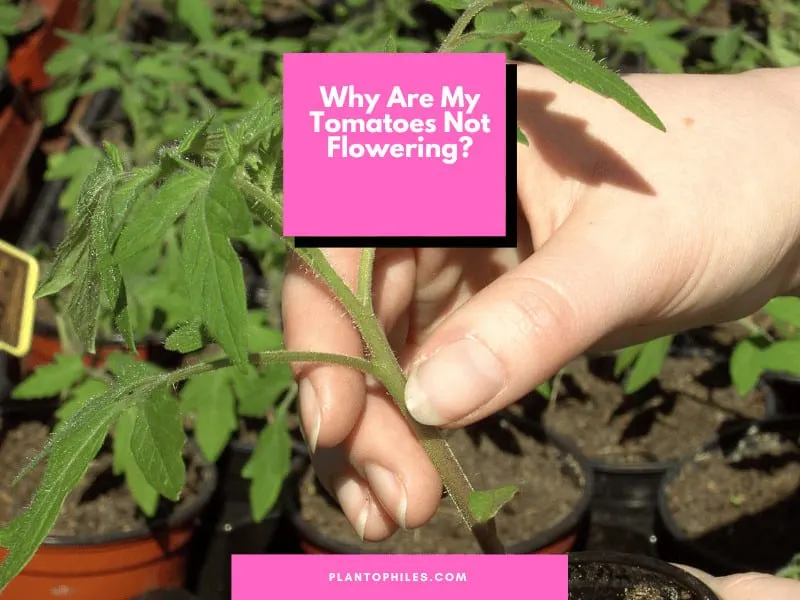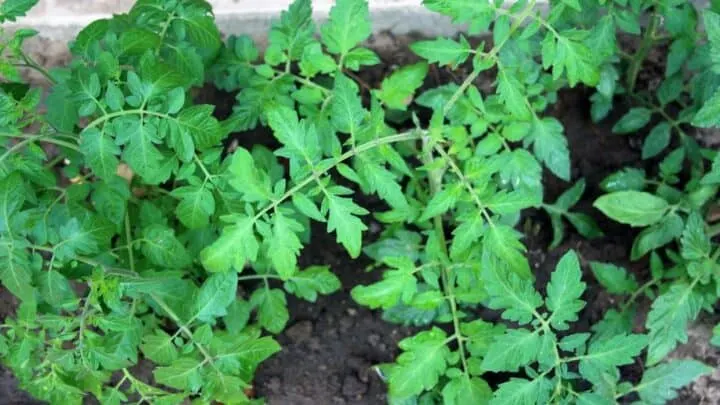Why are my tomato plants not flowering? On occasion, tomato plants will produce plenty of flowers yet lack the number of tomatoes that pop out.
In other situations, tomato plants may not make any flowers, leaving you wondering where things have gone wrong.
Gardeners spend a lot of time tending to their tomato plants, so it’s common for frustration regarding tomatoes not flowering.
I know that I’ve been in the position of looking very forward to devouring juicy tomatoes, only to be left with no fruit or flowers come blooming time.
Table of Contents
Why Are Tomatoes Not Flowering?
The main reason behind tomatoes not flowering typically lies in the soil quality. I recommend adding fertilizer to your plant, potted or in the ground, that does not contain nitrogen. If you still don’t have any flowers, disease, genetics, temperature, and nutrition may also be the culprits!

The Reasons Behind Lackluster Tomato Plants
A lackluster garden is disheartening.
Those who spend much time caring for our plants can understand how irritating it is to have tomato plants that won’t flower.
However, it’s crucial to remember that this flowering problem is usually very fixable.
1. Disease
Though tomato plants are very hardy and can grow and flourish without an overabundance of care, disease among your tomato plants is always possible.
Bacterial spot is the major player in killing tomato plants; because of them, your plant will not flower.
If you notice your plant wilting and the leaves covered in spots, it’s time to destroy the plant to prevent the bacteria from spreading to those around it.
Other diseases are early blight and late blight. Early blight starts on lower leaves with small black spots that grow larger. It is caused by Alternaria tomatophila & solani.
The fungus Phytophthora infestans cause late blight.
2. Poor Soil Nutrition
Lack of nutrition might be the reason your tomato plants won’t flower.
Essential nutrients in the soil may be depleted, or perhaps your soil is too rich in nitrogen to encourage flowering.
Many commercial fertilizers contain nitrogen, and gardeners must ensure they aren’t adding too much.
Choose a well-balanced fertilizer for your tomato plants, preferably a phosphate-based brand.
You can tell if your tomato plants have too much nitrogen when you’ve got healthy foliage but zero flowers.
3. Plant Genetics
Sometimes the genetics of your tomato plant may affect how it flowers and the number of tomatoes produced. In some cases, the plant is sterile.
A sterile plant often comes from store-bought seeds or a tomato you’ve sliced at home.
If you’ve purchased from a reputable nursery, sterilization is not likely a problem.
4. Poor Pollination
Tomatoes are unique in the fact that they can pollinate themselves. However, they’re not very good at it.
Tomatoes need wind, bees, and airflow to produce fruit and flowers successfully.
If your garden or living space lacks these three components, or if you’re growing your tomato plant in a pot indoors, then you will need to hand-pollinate the plant.
5. Temperature Issues
A rapid temperature change is unsuitable for your tomato plants; if it doesn’t kill them, it will keep them from flowering.
Warm, sunny, and well-ventilated conditions are necessary for healthy tomato plants.
When the weather in your area fluctuates, such as cold temperatures and night and hot during the day, you’ll want to bring your tomato plants inside for the night.
Of course, you can always resist putting them out right after the final frost. Give Mother Nature some time to level out.
Encouraging Tomato Plants to Flower
If you’ve been frustrated with the performance of your tomato plants, you are not alone. Luckily, you can do a few things to encourage them to flower and eventually produce fruit.
Planting indeterminate tomato plants, for example, will encourage growth and the production of fruit on the plant throughout the season.
Good air circulation helps plants to flower as well.
If your tomato plants don’t have air circulation, they won’t be able to self-pollinate. They’ll also need the assistance of local insects and bees.
Tomato plants that are too close together might have to be spaced evenly.
Adding phosphorus to the soil and ensuring that your plants have the perfect environment to thrive will provide you with flowering tomato plants year after year.
Sometimes, they need a little encouragement!
Flowers but no tomatoes
The weather is to blame if your tomato plants produce flowers but no tomatoes. Flower drop occurs when temperatures are too high or too low, according to Iowa State University.
Night-time temperatures should not fall below 55 degrees Fahrenheit (13 degrees Celsius) or 85 degrees Fahrenheit during the day (29 degrees Celsius).
Other reasons are strong winds and dry weather. In dry weather, ensure you are watering your tomato plants sufficiently. You may need to water them twice a day.
Frequently Asked Questions About Tomatoes Not Flowering
Why won’t my tomatoes flower?
Your tomato plants might not flower for many reasons, but most are fixable. Disease, lack of proper nutrition in the soil, extreme temperature fluctuation, disease, pollination, and genetics play a role in tomatoes not flowering.
If my tomato plants flower, will they produce fruit?
It’s possible, but there’s no guarantee that a flowering tomato plant will produce fruit. Late pollination may keep a tomato plant from growing actual tomatoes, or they might not have time to ripen.
Do I have to get rid of diseased tomato plants?
You should rid your garden of bacteria-infested tomato plants. They can transmit disease to surrounding plants, so it’s crucial to ensure that diseased plants are removed.
Why don’t my tomato plants have tomatoes?
Tomato plants don’t have tomatoes because they are either not pollinated or too stressed because of warm or cold weather and too much wind. Other reasons for no tomatoes are pest infestations, fungal diseases such as early blight, Septoria leaf spot, or improper nutrients.
Guaranteeing Flowering Tomato Plants
There is no way to guarantee that your tomato plants will flower, but you can take the necessary steps to ensure you’re doing what you can to help them. Tomatoes that are not flowering are quite frustrating.

Daniel has been a plant enthusiast for over 20 years. He owns hundreds of houseplants and prepares for the chili growing seasons yearly with great anticipation. His favorite plants are plant species in the Araceae family, such as Monstera, Philodendron, and Anthurium. He also loves gardening and is growing hot peppers, tomatoes, and many more vegetables.


